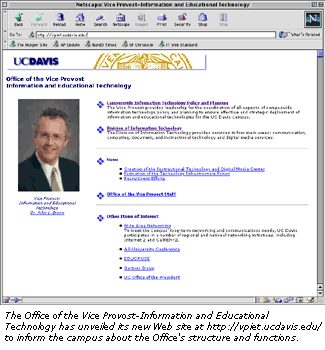 | |
 |
Web Site Highlights Campuswide Role By Richard Darsie
There's a new strand in the UC Davis Web. On May 1, the Office of the Vice Provost-Information and Educational Technology unveiled its new Web site. Located at http://vpiet.ucdavis.edu/, this site is part of a broader effort to inform campus administrators, faculty, staff, and students about the Office's structure and functions. When Vice Provost John Bruno assumed his post last September, he stepped into a new leadership role. Recommended by the Five-Year Administrative Unit Review (AUR) of Information Technology, this role is to fulfill two major functions: 1) campuswide information and educational technology policy and planning, and 2) oversight of the Division of Information Technology. Since last September, Dr. Bruno has engaged in discussions with many campus constituencies (including deans, vice chancellors, and faculty) about the direction that information technology should take to best serve the University's mission. These and other discussions have led Bruno to propose a structure for the Office of the Vice Provost as seen on the Web site at http://vpiet.ucdavis.edu/orgchart.html. "The structural changes I have proposed are based on the need for us to respond to the recommendations in the AUR report," says Dr. Bruno. "Considering the issues facing the campus now and in the years to come, we also need to position ourselves to anticipate, plan, and support a strong information technology infrastructure on campus. Tidal Wave II, for example, with its considerable anticipated enrollment growth, will present a number of challenges for which we must prepare." One of the ways in which Dr. Bruno plans to prepare the campus for these challenges is by playing a much stronger role in campuswide information technology policy and planning. This is one of two main functions around which the new Web site is structured. 
Information Technology Policy and Planning To fulfill this function, Dr. Bruno will continue to work very closely with the UC Davis Information Technology Coordinating Framework. Created in June 1998, the Framework is composed of the Information Technology Policy Board (ITPB), the Academic and Administrative Computing Coordinating Councils (AC4 and AdC3 respectively), and the Network Oversight Advisory Committee (NOAC). (See http://vpiet.ucdavis.edu/policy.html for more information.) Considering the challenges and complexity of campuswide information technology coordination, policy, and planning, a number of steps have been taken to strengthen and expand the Coordinating Framework. These steps include:
Oversight of the Division of Information Technology Some significant changes are in store for the Division. Following recommendations made in the AUR report, the Office of the Vice Provost is recruiting a Chief Operations Officer (COO), who will provide leadership, oversight, and day-to-day operational management of the Division. In addition, the Division's structure is being streamlined from six departments to four main categories of service. "One of the main reasons for this re-organization is the AUR Committee's and our own realization that the names given to several of our units are confusing," says Dr. Bruno. "We want to help our clients understand and quickly access the services we provide. Using more descriptive and intuitive names will help us achieve that goal." The four categories of divisional services under consideration follow:
Computing Services: This category covers hardware and software support as well as a variety of consultation and support services (currently provided by Information Resources). This category will also include audio visual equipment loan and repair services (currently offered by Creative Communication Services). Document Services: The focus here is on design services (print and Web), publishing, and printing services (currently offered by Creative Communication Services). Instructional Technology and Digital Media Services: These services are being consolidated in the new Instructional Technology and Digital Media Center scheduled to open in Fall 2000. The Center will provide a single entry point for faculty to a broad range of services in support of instruction and research. These include new media, photographic, media production, and scientific photography services. (See http://vpiet.ucdavis.edu/itdmc.html.) The transition of existing services to the new Center will occur once the Center's director is hired. Two other management positions for the Center are in recruitment: an Associate Director and a Management Services Officer (MSO). For more information, see http://vpiet.ucdavis.edu/recruit.html.
The site will be linked from the UC Davis Administration page (http://www.ucdavis.edu/administration.html), in company with other vice provosts' pages. For this reason, Dr. Bruno's site follows the format of these other pages. The launch of this site further illustrates that big changes are in store for information technology coordination, planning, and management at UC Davis. Updates will be posted regularly, so plan to visit the site periodically to keep up to date on these important endeavors.
|